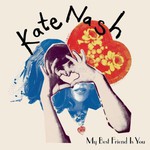My Best Friend Is You
Studio Album by Kate Nash released in 2010My Best Friend Is You review
First Nash instead of second Allen
Comparisons of a young star with a star of the world scale can be seen from different points of view. The young performer of pop- and indie-rock music Kate Nash knows it well. Even before the 2007 release of her debut long player, Made Of Bricks, she was named the follower of Lily Allen’s music. This was of great help regarding the promotion of Nash’s CD. Indeed, there were reasons to draw parallels between the two singers. They did sing about the same things and did it in a comparable fashion. Of course, the name of a big star had its good impact on the sales of Made Of Bricks. But it would be wrong to think that Kate Nash reached success only due to nice copying her older colleague. In the end, this simply would not be enough to get her CD to the chart top, and that was exactly what happened as early as in the year of the album’s release. Then it became clear to her that getting to new heights would take something different from just maintaining resemblance to the famous artist. She needed to obtain her own name and face in the world of music. After the delivery in the spring of 2010 of Kate’s second full-length effort, My Best Friend Is You, we can see that Kate Nash is nobody else but Kate Nash.
Rock-strike at pop-music
The young singer’s new album went though the producing work of Bernard Butler, former Suede guitarist, who has already established himself as a great producer after perfect collaboration with Duffy. This expert should be the one to blame for changing the pop/rock balance in Nash’s music to make it more rock-oriented. Punk is tangible not only in catchy choruses which you wait for impatiently during verses, but also in lyrics. Nash, who was a wise and far-looking teenager on her debut effort, is now singing lines that pretty simple and straightforward (again, like in punk). Examples are begging to be seen. The lead-single Do-Wah-Doo is a bold statement about a female person whom the singer clearly dislikes. I Hate Seagulls is just a song about things Nash does not like in this life. On the whole, the second album’s lyrics displays lots of feelings connected with abhorrence, protest or denial, which also is a feature of rock-music. Only in her verses Kate manages to conceal her negative attitude to someone or something with the help of apt irony. You can taste it in Kiss That Grrrl. The musical accompaniment is not aimed to form a detached image to draw your attention from the vocals. It only serves the purposes of background. While Nash’s first CD is a product of the contemporary British pop-music; this one features lots of noisy guitars and pays a tribute to the rock of the past decades.
Kate Nash’s vivid evolution
In some cases transition from pop-music towards indie-rock or even punk-rock is taken almost like demolition of one’s own musical future. As soon as Kate Nash provided herself with love and trust of huge masses in various countries, she practically targeted her next album at the so called musical minority. But in her case, this step looks quite a considerate move, a sign of the artist’s professional evolving. The singer started out working in a cozy field of pop-music to get herself a good name; and then she began exploring her own potential and trying her vocal and writing skills in different genres. This allowed her to leave the uneasy frames of stereotypes where her music was initially pushed by some critics and listeners. Yet now we have a performer who fuses pop-music with indie- and punk-rock, which is quite an interesting phenomenon. Add on here splendid singing and a recognizable style of lyrics, and you will get material that you want to listen to more and more. That is what the talented singer’s sophomore long player, My Best Friend Is You, presents.

